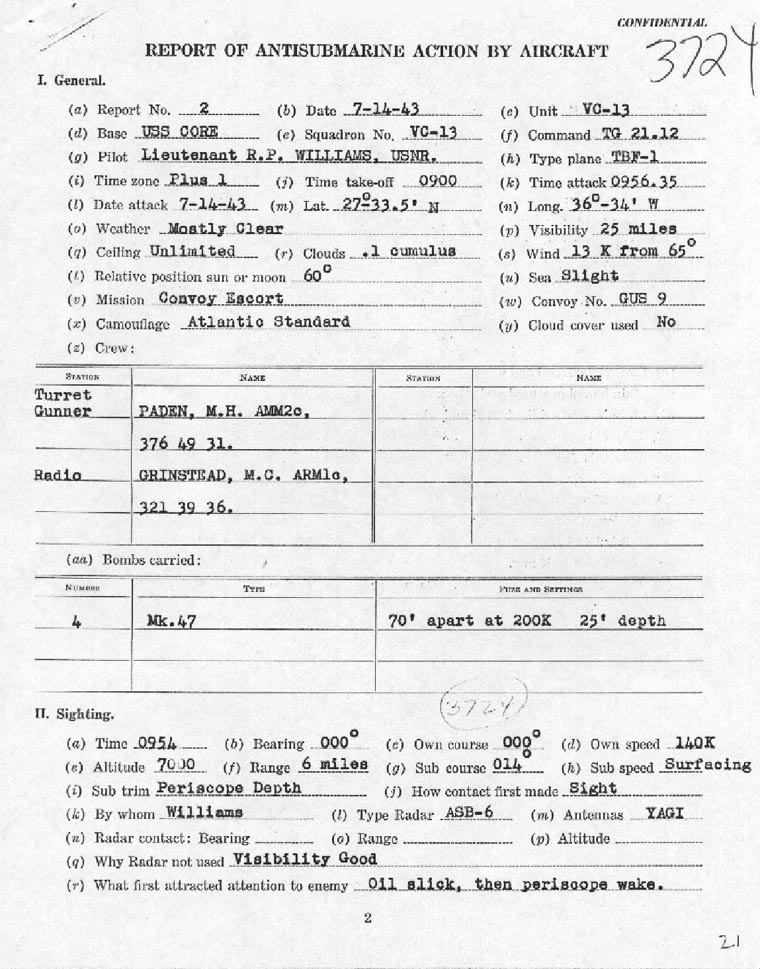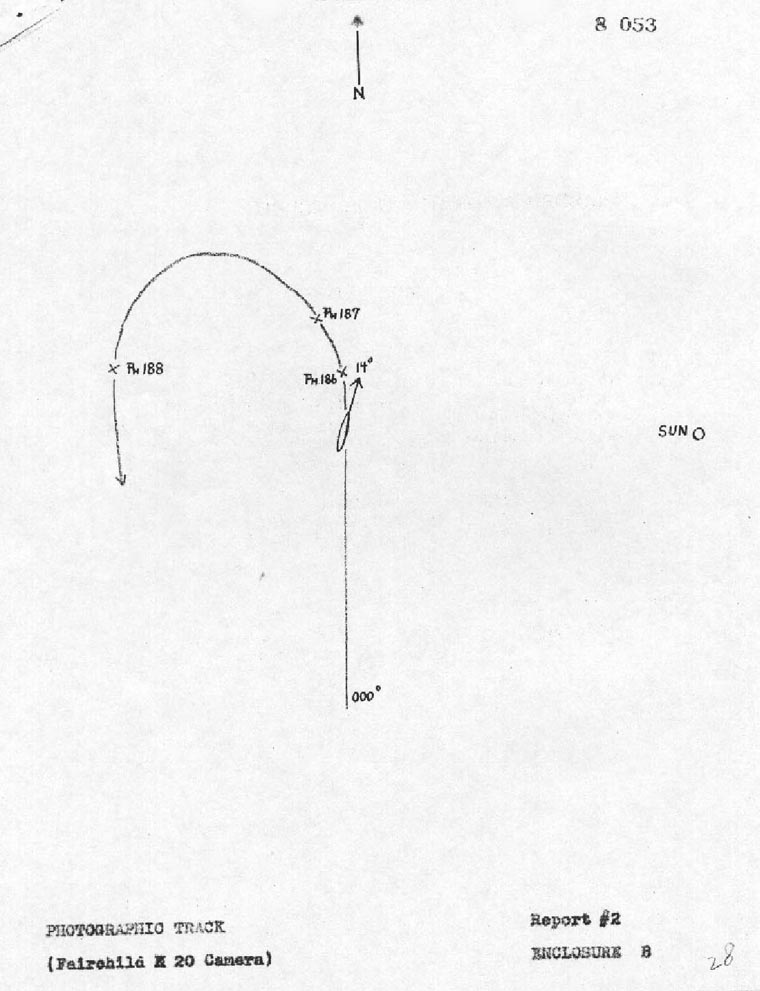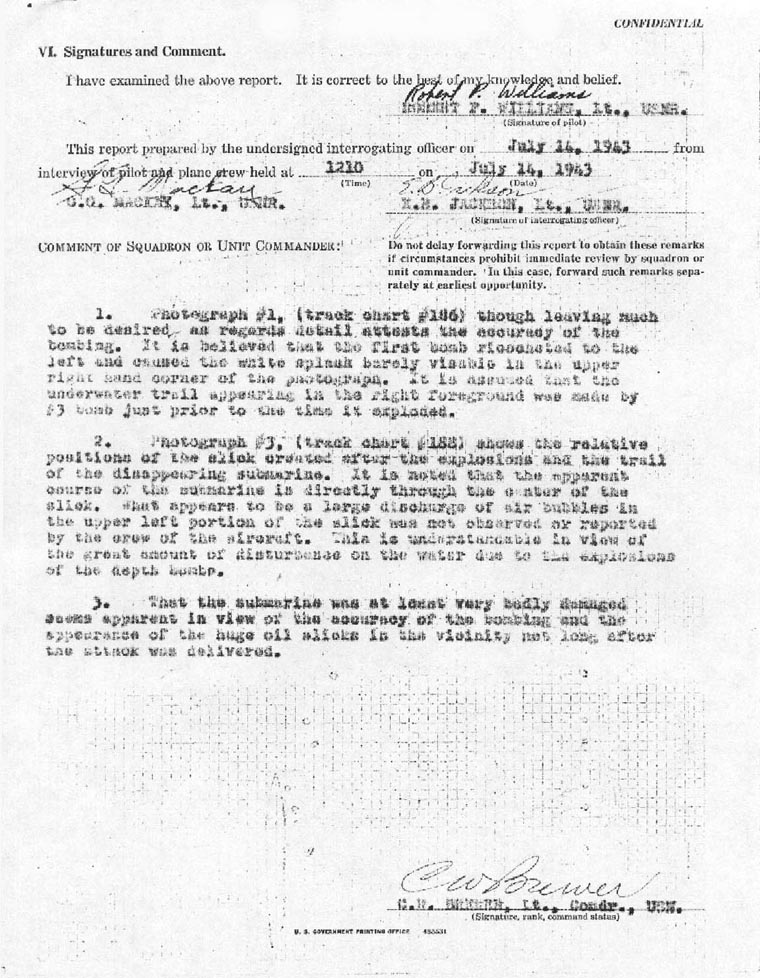

COMPOSITE SQUADRON THIRTEEN |
||
| July 14, 1943. | ||
| Flying the fifth leg of Aerial Escort Plan No. 15 on starboard side of convoy, altitude 7000 feet, course 2680T, speed 140 knots, visibility 25 miles, 0.1 cloud cover, radioman sighted an oil slick 9 miles on starboard beam at 0953. Sea was smooth with occasional whitecaps, wind 13 knots from 065. Pilot turned to North to investigate. After proceeding approximately two miles pilot noticed a periscope wake a mile beyond the oil slick, and immediately thereafter, a submarine surfacing on course 0140T, at very slow speed. The position was 27-35N and 36-34W, 309 miles from the convoy on a bearing of 3500. | ||
| On sighting wake at 0954, pilot nosed over and commenced his approach on the U-boat's starboard quarter without having to alter his course. Final portion of the approach was made in a flat glide of about 100 at a speed of around 220 knots. Four Mark 47 depth bombs set for a depth of 25 feet were released from an altitude of 150 feet by intervalometer set for a 70 foot spacing at 200 knots. The submarine was approximately three quarters surfaced at the time of release. | ||
| Only the radioman, photographing through the tail gun aperture, saw the bombs hit the water, the turret gunner's vision being obscured by the empennage at the instant. The radioman observed the first bomb strike the water on the submarine's starboard quarter close aboard. Either this bomb ricocheted to the left across the U-boat or the second bomb bounced to the left from the U-boat's deck. The remaining bombs were "overs" off the port bow. Water thrown up by the explosions blanked the submarine from sight. The radioman and gunner believed that all four bombs exploded but were not certain. As the disturbance subsided, submarine was observed to disappear on a fairly even keel, with apparently little way on, in about 4 seconds time. | ||
| Pilot observed the area and saw, what he took and reported to be, an oil and depth charge slick of about two or three hundred feet diameter. He dropped a dye marker, climbed and circled. The slick gradually dissipated and was completely gone at 1110. | ||
| At 1006 relieving planes, 2 TBF-1s and 1 F4F-4 were catapulted to assist Williams. At 1145 Williams was ordered back to the ship. One of the relieving planes sighted at 1300 fresh oil slick about 600 feet x 1500 feet 6-8 miles NE of the original contact. Another slick, about 900 feet x 150 feet was reported at 1430 8-10 miles North of the contact point. Subsequent to sighting these slicks two destroyers, U.S.S. BULMER and U.S.S. ERICSSON, were dispatched to the area. RElieving planes remained in the area conducting baiting tactics until arrival of the destroyers and then searched until sundown. The last TBF leaving the area reported that one of the destroyers had dropped depth charges shortly before the plane's departure. | ||
| ENCLOSURE (A) | ||
COMPOSITE SQUADRON THIRTEEN |
||
| July 14, 1943. | ||
| At 0600 July 15 a TBF and an F4F were launched to search the area of the attack which was then 175 miles astern of the convoy. Planes returned to the ship at 1050. Results of search negative. The destroyers broke off search about 0900 July 15, rejoining convoy at 2003 and reporting. "We made one attack just before dark and several more during the night. Sorry we couldn't stay there today. He is apparently hurt and can't go very fast. I believe we could have bagged him before long." Three oil slicks were encountered in the area by the destroyers. A separate report is being submitted by U.S.S. BULMER. | ||
| On release from the convoy July 17 the ship proceeded back to the vicinity of this attack, arriving July 19, and searched area from 160 miles west of attack to 240 miles east, and 25 miles south to 315 miles northeast. On July 20 this area was extended to the northeast to 360 miles and to the southeast to 200 miles. The area to the northeast was again searched on July 21. Results were negative on all searches. | ||
| Enclosure (A) | ||
- 2 - |
||

